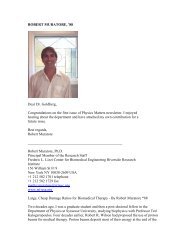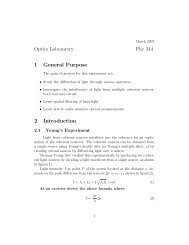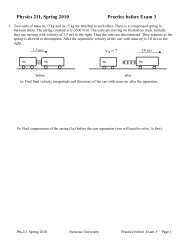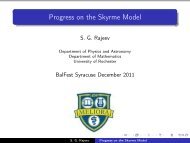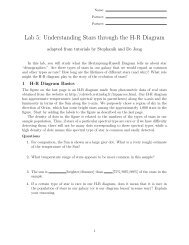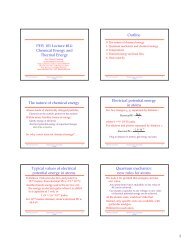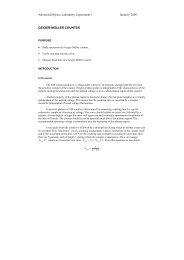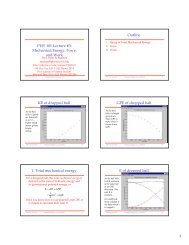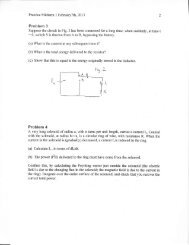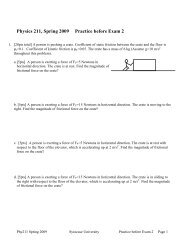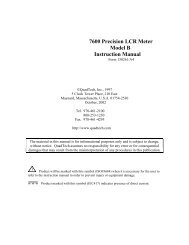PHY 101 Lecture #1 - Physics
PHY 101 Lecture #1 - Physics
PHY 101 Lecture #1 - Physics
- No tags were found...
Create successful ePaper yourself
Turn your PDF publications into a flip-book with our unique Google optimized e-Paper software.
Outline<strong>PHY</strong> <strong>101</strong> <strong>Lecture</strong> <strong>#1</strong>:Introduction to <strong>PHY</strong> <strong>101</strong>1. Introduction to <strong>PHY</strong> <strong>101</strong>2. Introduction to our subject: ENERGYProf. Peter R. Saulsonsaulson@physics.syr.eduhttp://physics.syr.edu/courses/<strong>PHY</strong><strong>101</strong>/Rm 263-4, <strong>Physics</strong> Bldg., 3-5994<strong>PHY</strong> <strong>101</strong> <strong>Lecture</strong> <strong>#1</strong> Introduction to <strong>PHY</strong> <strong>101</strong> 1<strong>PHY</strong> <strong>101</strong> <strong>Lecture</strong> <strong>#1</strong> Introduction to <strong>PHY</strong> <strong>101</strong> 21. <strong>PHY</strong> <strong>101</strong>All course documents are available on:http://physics.syr.edu/courses/<strong>PHY</strong><strong>101</strong>/including:– Syllabus–Course Calendar– Homework assignments– <strong>Lecture</strong> Notes– Laboratory exercises<strong>PHY</strong> <strong>101</strong> <strong>Lecture</strong> <strong>#1</strong> Introduction to <strong>PHY</strong> <strong>101</strong> 3<strong>PHY</strong> <strong>101</strong>: What is it?• An introductory course in physicsno prerequisites• On the Basic List in Natural Sciences andMathematics• Satisfies req’t for “course with laboratory”• Gives an overview of physics and its application toother fields of study• Recommended by ESF Biology for breadth ofapplications• Not the best choice if you intend to major in <strong>Physics</strong> –please see me after class.<strong>PHY</strong> <strong>101</strong> <strong>Lecture</strong> <strong>#1</strong> Introduction to <strong>PHY</strong> <strong>101</strong> 4<strong>PHY</strong> <strong>101</strong>: ObjectivesIn this course, expect to learn something of– How the world is put together and how it works– The scale of physical processes• how big?•how much?• (how expensive?)–Why ENERGY is a powerful unifying concept– How science works, and what are its limitsExpect to use numerical reasoning, learn keynumbers, read graphs, learn and use formulas<strong>PHY</strong> <strong>101</strong>: TextbookText is Energy: Physical, Environmental, and SocialImpact, by Gordon J. Aubrecht.This book is especially strong on the topicsmentioned in its subtitle.<strong>Lecture</strong>s will focus on the physics aspects, butwe’ll turn periodically to the wider contextcovered in the book.<strong>PHY</strong> <strong>101</strong> <strong>Lecture</strong> <strong>#1</strong> Introduction to <strong>PHY</strong> <strong>101</strong> 5<strong>PHY</strong> <strong>101</strong> <strong>Lecture</strong> <strong>#1</strong> Introduction to <strong>PHY</strong> <strong>101</strong> 61
<strong>PHY</strong> <strong>101</strong>: Work• <strong>Lecture</strong>s: Tues & Thurs 8:00 - 9:20 a.m.• Studio meetings weekly, for 2 hours– submission and discussion of homework, and– hands-on engagement with key ideas through labexercises• Reading and homeworkAssigned each week. This is your best preparationfor exams, so do it!Homework graded each week. Do it on time.• Two mid-term exams, plus Final Exam<strong>PHY</strong> <strong>101</strong> <strong>Lecture</strong> <strong>#1</strong> Introduction to <strong>PHY</strong> <strong>101</strong> 7<strong>PHY</strong> <strong>101</strong>: Exams• First Mid-term examThursday 21 September (in lecture)• Second Mid-term examThursday 26 October (in lecture)• FINAL EXAMTHURSDAY, 14 DECEMBER, 12:30 – 2:30 P.M.<strong>PHY</strong> <strong>101</strong> <strong>Lecture</strong> <strong>#1</strong> Introduction to <strong>PHY</strong> <strong>101</strong> 8Components:1st mid-term: 15%2nd mid-term: 25%Final Exam: 35%Homework: 10%Laboratory: 15%Scale:90% A-80% B-60% C-<strong>PHY</strong> <strong>101</strong>: Grades<strong>PHY</strong> <strong>101</strong> <strong>Lecture</strong> <strong>#1</strong> Introduction to <strong>PHY</strong> <strong>101</strong> 9<strong>PHY</strong> <strong>101</strong>: Lateness and MakeupsLate homework:Will not be accepted for credit after answer key isposted (usually each Thursday), so do it on time.Mid-term exams:No written makeup exams. If you have an excusedabsence, you must take an oral examination withProf. Saulson.Final Exam:NO FORM OF MAKE UP FINAL EXAM FOR ANYREASON.<strong>PHY</strong> <strong>101</strong> <strong>Lecture</strong> <strong>#1</strong> Introduction to <strong>PHY</strong> <strong>101</strong> 10<strong>PHY</strong> <strong>101</strong>: Speaking to us• Prof. Saulson’s office hours:Tuesdays 9:30 – 11:00 a.m., in Rm. 263-4 <strong>Physics</strong>.or, make an appointment: saulson@physics.syr.edu• Prof. Schwarz’s Problem Sessions:Room 202/204, <strong>Physics</strong> BuildingMondays and Tuesdays 5:15 – 6:16 p.m.• TAs will post their <strong>Physics</strong> Clinic hours shortly.• Visit any TA in <strong>Physics</strong> Clinic for help.• For clerical matters, see Arlene Johnston in Room111, <strong>Physics</strong> Bldg.<strong>PHY</strong> <strong>101</strong>: A personal noteI hope you all are excited to be taking thecourse. For some of you, it will be easy. Forothers, a challenge.If you work hard, you will learn things that willhelp you to understand the world in aprofound way.Let’s each resolve to put forth our strongest andbest efforts.<strong>PHY</strong> <strong>101</strong> <strong>Lecture</strong> <strong>#1</strong> Introduction to <strong>PHY</strong> <strong>101</strong> 11<strong>PHY</strong> <strong>101</strong> <strong>Lecture</strong> <strong>#1</strong> Introduction to <strong>PHY</strong> <strong>101</strong> 122
2. EnergyCentral Theme of <strong>PHY</strong> <strong>101</strong> is ENERGYEnergy is one of the great unifying ideas in physics.It is the key to understanding the application ofphysics to subjects as wide-ranging as:chemistrybiology, physiology and ecologyeconomics and geographynutrition and exercise scienceengineeringTo guide your thinking and studying in<strong>PHY</strong> <strong>101</strong>: Always ask about energy!<strong>PHY</strong> <strong>101</strong> <strong>Lecture</strong> <strong>#1</strong> Introduction to <strong>PHY</strong> <strong>101</strong> 13Origin of the concept of energyNewton (1642 – 1727) invented physics, but hedidn’t know about energy.Concept was developed in the mid-19th cent.Scientists and philosophers were searching for– an idea that unified all phenomena,– some unchanging property of the world, giving ahidden unity to the constant processes of change.By the 1840s, it was discovered which propertyof the world never changed. That propertywas called energy.<strong>PHY</strong> <strong>101</strong> <strong>Lecture</strong> <strong>#1</strong> Introduction to <strong>PHY</strong> <strong>101</strong> 14What is energy?“Energy is conserved.”We will devote the course to investigating thequestion, “What is energy?”Energy is hard to define in the abstract, so wewill answer the question by example.Is energy a substance, a quality, a book-keepingdevice, a system of exchange rates, or …?Key idea: ENERGY is CONSERVED.Meaning: Energy is neither created nor destroyed.Exploring the idea of conservation is the key tounderstanding what energy is.<strong>PHY</strong> <strong>101</strong> <strong>Lecture</strong> <strong>#1</strong> Introduction to <strong>PHY</strong> <strong>101</strong> 15(Note different meaning than colloquial English, “Youshould conserve energy!”)“Energy is conserved” means “Amount of energyalways stays the same.” How can this be interesting?Always staying the same sounds boring.Key idea is energy transformation from one form toanother.This idea links disparate phenomena, revealing an underlyingunity.We’ll study many forms of energy and their interrelationships.<strong>PHY</strong> <strong>101</strong> <strong>Lecture</strong> <strong>#1</strong> Introduction to <strong>PHY</strong> <strong>101</strong> 16Conservation/transformation ina hand-cranked radioIts energy conservation/transformation story is:mechanical kinetic energy of hand, becomingelastic potential energy in spring, becomingmechanical kinetic energy in gears, becomingelectrical energy in generator and circuit, becomingsound energy in loudspeaker.Linked to:electromagnetic wave energy from radio station,chemical energy in my body, from food, from Sun,and whatever I influence after listening to radio ...<strong>PHY</strong> <strong>101</strong> <strong>Lecture</strong> <strong>#1</strong> Introduction to <strong>PHY</strong> <strong>101</strong> 173




